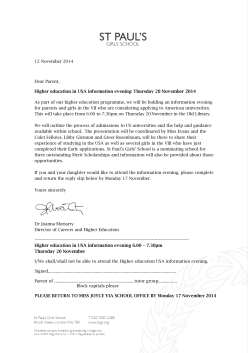
Transnational Meanings of the American Civil War
The Civil War as Global Conflict: Transnational Meanings of the American Civil War (Review) By: Kathelene McCarty Smith Smith, K.M. (2015). [Review of The Civil War as Global Conflict: Transnational Meanings of the American Civil War]. The Southeastern Librarian, 62(4), 31. Made available courtesy of Southeastern Library Association: http://selaonline.org/publications/index.htm ***© Southeastern Library Association. Reprinted with permission. No further reproduction is authorized without written permission from Southeastern Library Association. *** Abstract: This article is a review of the book The Civil War as Global Conflict: Transnational Meanings of the American Civil War edited by David T. Gleeson and Simon Lewis. Keywords: Book Review | History | American Civil War | International Perspectives ***Note: Full text of article below ISSN: 0038-3686 Brunswick, Georgia, by a magnificent six-mile stretch of marshland.”(Introduction 1) Given the footprint of the island, it is fascinating that the author presents her research on 280 pages, which includes 66 pages of Notes, a Selected Bibliography and an Index. Her research centers on the years prior to the formation of the famous Jekyll Island Club of 1886. She explains that human conflict and a natural environment did not always produce the tranquility and refuge many of us seek on an island. She explains how the world and world issues found Jekyll Island and its inhabitants. For lovers of Sea Island history, McCash’s in depth research gives the reader maps, architectural designs, drawings, portraits, and scenes of daily life. Her research is distinct and unique since previous research on Jekyll focused on the periods following 1886, beginning with the Chicago Literary Club in 1882 and a spoof by its members, “The Legends of Jekyl Island”, that may have started the move to bring the world to Jekyll’s shores. Dr. Carol Walker Jordan College of Library and Information Studies University of North Carolina at Greensboro The Civil War as Global Conflict: Transnational Meanings of the American Civil War. Edited by David T. Gleeson and Simon Lewis. Columbia, SC: The University of South Carolina Press, 2014. ISBN 978-1-61117-325-3. $49.95. The genesis for this fascinating scholarly collection, The Civil War as Global Conflict: Transnational Meanings of the American Civil War, was a 2011 conference held by the Carolina Low Country and Atlantic World Program at the College of Charleston. It is comprised of a collection of essays that frame the American Civil War not as a solely national conflict but as part of larger global events relating to economics, slavery, democracy, and national identity. It moves beyond a purely American perspective of the war into one which factors in the international externalities, revealing the political and economic codependency of the United States and other world powers. The editors, David Gleeson and Simon Lewis, group the essays into three areas of study. The first describes the prelude to the War in the United States; the second focuses on European sociological perspectives concerning race, abolitionism, and slavery; and the third deals with the aftermath and legacy of the Civil War domestically and abroad. In the book’s first section, Gleeson and Lewis selected essays that contextualize slavery within the global economy, concentrating on the American South’s confidence in their slave-based agricultural system and the assurance of their political position within the Europeandominated world. These chapters show how the South’s fear of economic collapse and slave insurrection ultimately led to the American South holding on more tightly to slavery while Europe began to embrace abolition throughout their colonial holdings. Trusting the international community would eventually return to slavery because of examples of failing island economies led the South to become overconfident in their position – especially with the strength of “King Cotton” in the world economy. While the first chapters describe the global atmosphere that drove the South’s political calculus leading to the war, the second section focuses on more specific examples of international perspective. Shifting to pure European postCongress of Vienna politics, Niels Eichhorn’s chapter, “The Rhine River,” describes how the actions taken by the Prussians to block French expansion following annexation of Nice and Savoy, as well as general fears of French ambitions on the German side of the Rhine River, created a tense political situation, which drew potential European support for the beleaguered South. Although these events took place thousands of miles away from the States, the events ultimately bound Great Britain into a politically neutral stance in America, crushing the possibility for Southern success. The third section covers a variety of subjects dealing with the legacy of the Civil War, including the impact of Florence Nightingale on women during the Civil War, a South African perspective on Gone with the Wind, and a very interesting discussion on memorializing the War. Jane Shultz’s commentary on Florence Nightingale makes interesting points regarding the internationally famous nurse as an icon, heroine, and English role model for many American women facing the horrors of their nation’s war. Her name literally became synonymous with war nursing -an image of a feminine “saintly warrior.” The idea of legacy takes a completely different turn in Lesley Marx’s “Race, Romance, and ‘The spectacle of unknowing’ in Gone with the Wind: A South African Response,” the story of a young girl from South Africa viewing the movie for the first time, creating a nostalgia for American antebellum history while living in a political and social environment of racism. The final essay effectively deals with the larger historic perspective of the war including the thoughts on the subject from a variety of scholars, leading the reader to consider the true legacy of the war. Volume 62, No. 4, Winter 2015 31 From illustrations of international policy and historical effects to sociological evolutions, these essays create a compelling series that pulls an American reader out of the conditioned historical isolationism and American exceptionalism fallacies pervasive in U.S views on history and into a view of the Civil War that recognizes the impact of international events and perspectives. It is an interesting read for both historians and others who have an interest in Civil War History. Kathelene McCarty Smith The Martha Blakeney Hodges Special Collections and University Archives The University of North Carolina at Greensboro Madam Belle: Sex, Money, and Influence in a Southern Brothel. Maryjean Wall. Lexington, KY: University Press of Kentucky, 2014. ISBN 978-0-8131-4706-2 $24.95 The superior work has some connection to the southern USA by content since the splendid masterpiece is about Belle Brezing, who managed a famous lady of the evening establishment in Lexington, Kentucky. The author’s association with the southern USA is the author Maryjean Wall who teaches at the University of Kentucky History Department. The writing style is superior and enchants the reader’s attention from start to finish. The perceived interest to the readership of the journal is outstanding due to the excellent intriguing details on nineteenth century Lexington, Kentucky including horse racing, human living conditions, ladies of the evening, and the movement from horse and buggy to automobiles, dirt roads to brick roads, and the addition of electricity, sanitation, and the telephone. The magnificently and profoundly researched contents include Preface, Chapter One “The Elegant Miss Belle,” Chapter Two “Civil War and Home War,” Chapter Three “A Troubled Youth,” Chapter Four “A Business Woman Whose Business Was Men,” Chapter Five “Networks of Power,” Chapter Six “A Wealthy Benefactor,” Chapter Seven “Lexington’s Exclusive Mansion for Men,” Chapter Eight “A Uniquely Powerful Woman in a Changing City,” 32 The Southeastern Librarian Chapter Nine “Crackdown on Vice,” Chapter Ten “A Growing Moral Menace,” Chapter Eleven “The Passing of a Legend,” Epilogue, Acknowledgements, a seventeen page Notes, a Bibliography divided by primary and secondary sources, and an accurate Index. Twenty-six black and white photographs reveal beautiful and exciting places, buildings, and memorabilia of Belle Brezing’s life. Twelve black and white photographs disclose the beauty and handsomeness of Belle Brezing and her companions and patrons. Belle was married to James Keeney who left her so quickly it was as if he was never her husband. Belle’s sole child was Daisy May Kenney whose real father is unknown. Belle shipped off Daisy May Keeney to live with nuns because Daisy May was believed to be suffering from retardation. Belle was a lady of the evening at fifteen on her own prior to entering in the ladies of the evening establishment directed by Jennie Hill. Belle’s own initial house for ladies of the evening was on Upper Street. Belle had an increase in patrons when horse races were occurring. Horses were bought and sold at Belle Brezing’s ladies of the evening establishment. Some race horses mentioned are Lady Thorn, Director, Mambrino Chief, Abdallah, Almont, Harry Wilkes, Goldsmith Maid, JayEye-See, Regret, George Wilkes, Patchen Wilkes, Hindoo, Preakness Stud, Behave Yourself, Bubbling Over, Burgoo King, Broker’s Tip, Firenze, Miss Woodford, and Man O’ War. Thirty four people wrote in Lexington Daily to stop ladies of the evening. Ms. Brezing and other ladies of the evening were declared nuisances by the court February 13, 1889. Belle’s location was around Kentucky University and Kentucky schools which created a frown by Kentucky University president and the Kentucky school board. Belle left North Upper Street for a Megowan Street house purchase using a fifty thousand dollar present from the wealthy George and William Singerly who had money from their father’s Philadelphia Germantown Passenger Railway Company valued in 2013 at 16.5 million dollars. Law enforcement did not tamper with the ladies of the evening in the designated red light area Megowan Street. Belle’s ladies of the evening were extremely prosperous with utilization of phaetons, drivers and buggies, and extremely elegant attire. Astonishingly, citizens of Argentina where Kentucky horses were sold were aware of Belle. Belle and her ladies were exclusively allowed to shop for clothes in boutiques after the boutiques had closed shop for the day. In 1915, courts were better at ending ladies of the evening. Fines were issued to a person in the red light area and females acting as ladies of the evening. Initially, there was no successful finale to ladies of the evening establishments in Lexington due to the aid by the Lexington city leaders and police for the ladies of the evening. 1800’s Victorians were accepting of ladies of the evening, too. However, Progressives in the 1900’s averted ladies of the evening. Business earnings such as rent, doctor bills,
© Copyright 2025









